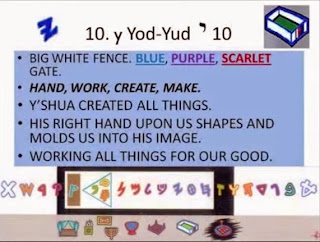Hashamayim: Hashamayim is spelled HEY (H), SHIN (Sh), MEM (M), YOD (Y) and MEM (M).
“The heavens” is comprised of the Hebrew letters HEY (represented in the ancient Hebrew pictographs as a man standing with open arms, and meaning grace or to behold). SHIN (Sh)(pictured as two teeth, and meaning to consume or destroy). MEM (M)(pictured as waves of water, and meaning waters or peoples or nations). YOD (Y)(pictured as the arm from the fist to the elbow, meaning my hand or works). MEM (M)(pictured as waves of water, and meaning waters or peoples or nations).
The word mayim (spelled in Hebrew MEM YOD MEM) is the Hebrew word for water. Put together the pictograph reveals ' BEHOLD, the WORK of your HAND will be DESTROYED by WATER'.
“The heavens” is comprised of the Hebrew letters HEY (represented in the ancient Hebrew pictographs as a man standing with open arms, and meaning grace or to behold). SHIN (Sh)(pictured as two teeth, and meaning to consume or destroy). MEM (M)(pictured as waves of water, and meaning waters or peoples or nations). YOD (Y)(pictured as the arm from the fist to the elbow, meaning my hand or works). MEM (M)(pictured as waves of water, and meaning waters or peoples or nations).
The word mayim (spelled in Hebrew MEM YOD MEM) is the Hebrew word for water. Put together the pictograph reveals ' BEHOLD, the WORK of your HAND will be DESTROYED by WATER'.
Moshe:
Moses, in Hebrew, is Moshe. Moshe is spelled MEM (M), SHIN (Sh) and HEY (H). When Pharoh’s daughter finds Moses in the river, “[S]he named him Moshe, saying, ‘I drew him out of the water.'” Exo. 2:10.
Hashamayim is also a visual representation of Moses being drawn out of the water. Here is the picture, notice the arm extending into the water and drawing Moses out.
In the first table is the pictograph for Hashamayim and in the second table is the pictograph in the rear mirror view showing Moshe being drawn out of the water by the hand.
Where Hashamayim means ' BEHOLD, the WORK of your HAND will be DESTROYED by WATER' , Moshe will be saved from this destruction and will be drawn out of it.
Parting the Red Sea:
Ex 14:21 Then Moshe stretched out his hand over the sea; and Yahuah swept the sea back by a strong east
wind all night and turned the sea into dry land, so the waters were divided.
The first table shows the Hashamayim in pictographs and the second table shows Moses parting the Red sea by the hand of Alahim in pictographs.
Ex 14:16 But lift thou up thy rod, and stretch out thine hand over the sea, and divide it: and the children of Israel shall go on dry ground through the midst of the sea.
The rod in Moses hand was to perform the signs of Yahuah. It was Yahuah's hand that would bring the deliverance to the children of Yisharal.
Where Hashamayim means ' BEHOLD, the WORK of your HAND will be DESTROYED by WATERS' , Moses parting the Red Sea in the rear mirror effect shows 'The WORK of your HAND will PART the WATERS from DESTRUCTION BEHOLD'
Moshe stood in the office of Yahusha and his name and his work signifies what Yahusha will do for us.
Gen1:6 Then Alahim said, Let there be an expanse in the midst of the waters,
and let it separate between the waters and the waters.
Gen1:7 Alahim made the expanse, and separated between the waters
which were below the expanse and the waters which were above the expanse; and it was so
Gen1:8 Alahim called the expanse heaven (shamayim).
And there was evening and there was morning, a second day.
The creation account was prophetic of the saving work of Yahusha.
Gen1:2 The earth was without form and void, and darkness was over the surface of the deep,
and the Spirit of Alahim was moving over the surface of the waters.

































